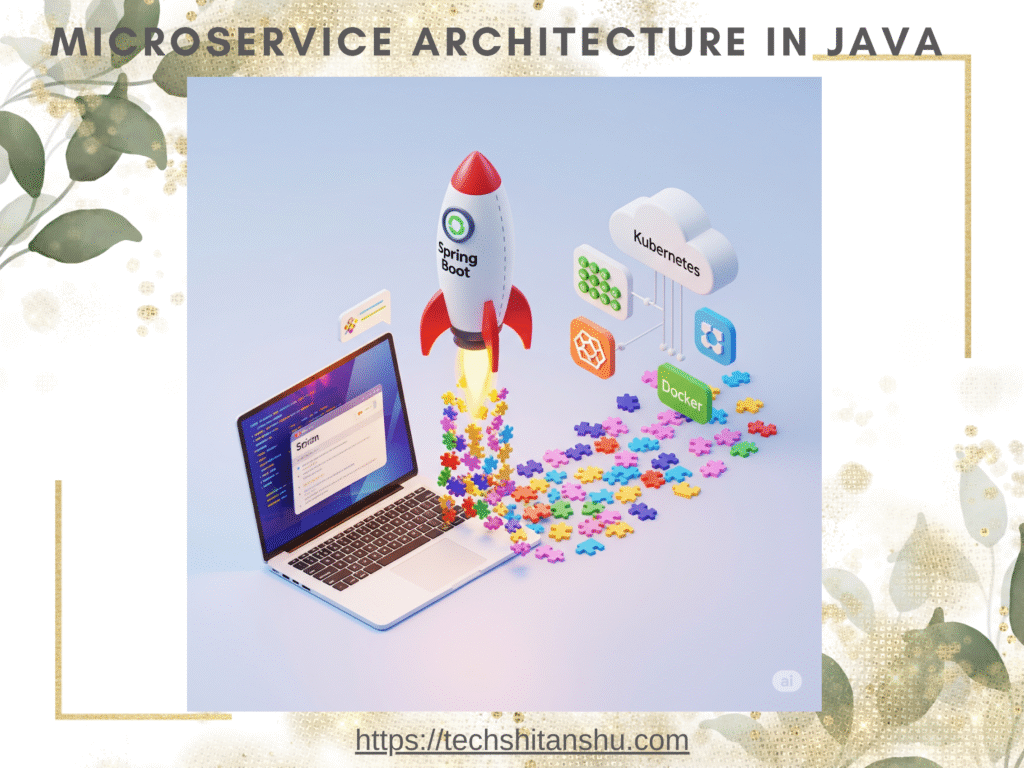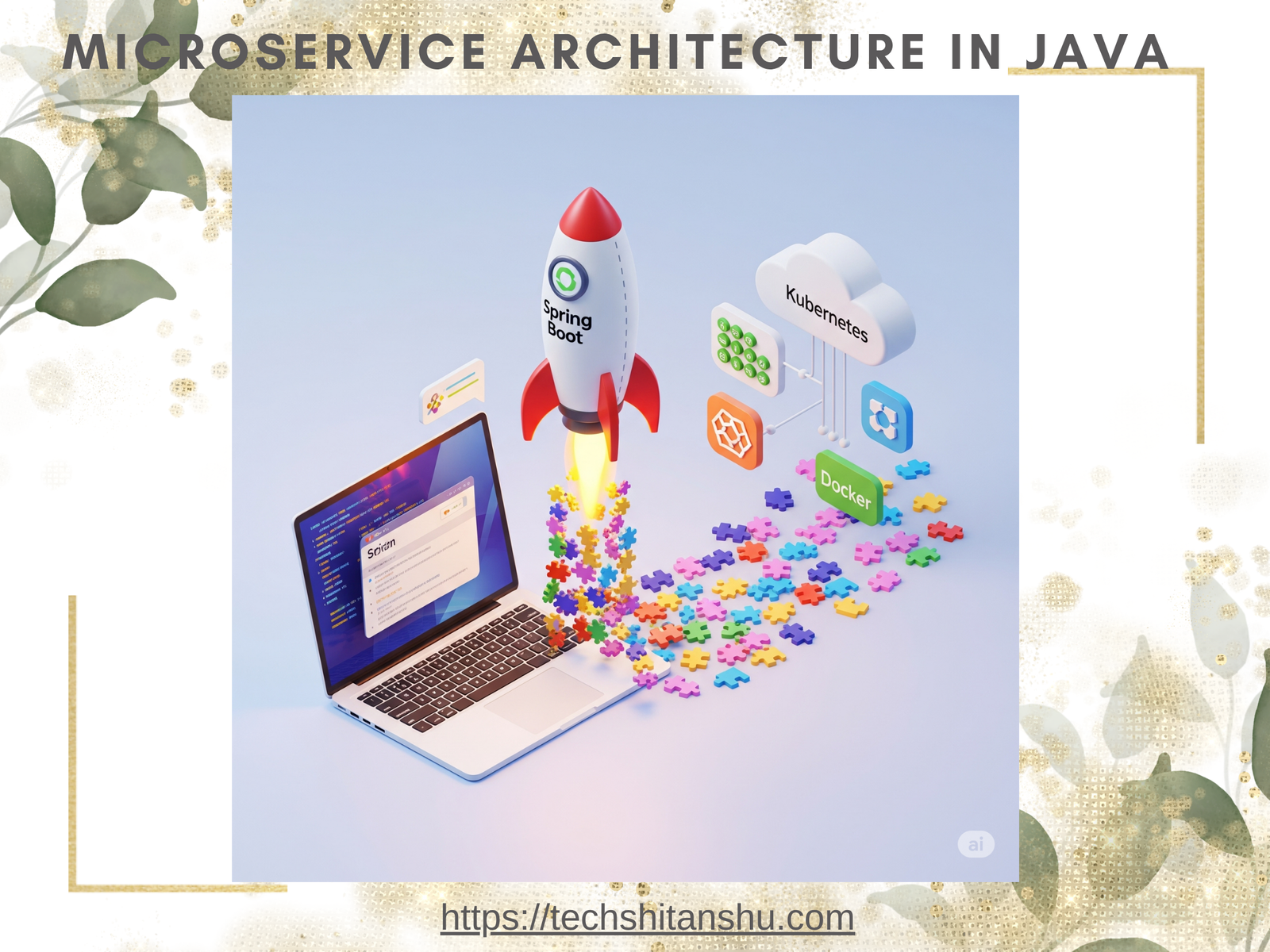Microservice Architecture In Java
Spring Boot makes it easy to create stand-alone, production-grade Spring based Applications that you can “just run”.
We take an opinionated view of the Spring platform and third-party libraries so you can get started with minimum fuss. Most Spring Boot applications need minimal Spring configuration.

1. Introduction to Microservice Architecture in Java
Microservice Architecture (MSA) is a modern software development approach where applications are built as a collection of small, independent, and loosely coupled services. Each microservice runs in its own process and communicates via lightweight protocols like HTTP/REST or messaging queues.
Unlike monolithic applications, where all functionalities are tightly integrated, microservices allow developers to:
Scale individual components independently.
Use different technologies for different services.
Deploy updates without affecting the entire system.
Java, being a robust and versatile language, is widely used for building microservices due to its strong ecosystem, frameworks, and enterprise support.
2. Why Use Microservice Architecture in Java ?
Java is a preferred choice for microservices because of:
✅ Platform Independence – Runs on any system with JVM.
✅ Strong Ecosystem – Rich libraries and frameworks (Spring Boot, Micronaut, Quarkus).
✅ Enterprise-Grade Security – Built-in security features.
✅ High Performance – Optimized for scalability.
✅ Community & Support – Large developer community and enterprise backing.
Popular companies like Netflix, Uber, and Amazon use Java-based microservices for scalability and resilience.
3. Key Characteristics of Microservices
Decentralized – Each service is independently deployable.
Single Responsibility – Focuses on one business capability.
Independent Data Management – Own database per service.
Lightweight Communication – Uses REST, gRPC, or messaging (Kafka, RabbitMQ).
Fault Isolation – Failure in one service doesn’t crash the entire system.
Automated Deployment – CI/CD pipelines enable rapid updates.
4. Microservices vs. Monolithic Architecture
| Feature | Monolithic Architecture | Microservice Architecture |
|---|---|---|
| Codebase | Single, large codebase | Multiple small services |
| Scalability | Scales as a whole | Individual services scale independently |
| Deployment | Single deployment unit | Independent deployments |
| Technology | Limited to one stack | Polyglot (multiple languages) |
| Fault Tolerance | Single point of failure | Isolated failures |
👉 When to Choose Microservices?
Large, complex applications requiring scalability.
Teams working on different modules independently.
Need for frequent updates without full redeployment.
5. Popular Java Frameworks for Microservices
1. Spring Boot & Spring Cloud
Simplifies microservice development with auto-configuration.
Integrates with Netflix OSS (Eureka, Hystrix, Zuul).
2. Micronaut
Lightweight, fast startup (ideal for serverless).
Compile-time dependency injection.
3. Quarkus
Optimized for Kubernetes and GraalVM.
Low memory footprint.
4. Dropwizard
Simple, production-ready RESTful services.
Bundles Jetty, Jersey, and Metrics.
5. Vert.x
Event-driven, non-blocking I/O for high performance.
6. Building a Microservice in Java: Step-by-Step
Step 1: Set Up a Spring Boot Project
Copy
Download
spring init --dependencies=web my-microservice
Step 2: Create a REST Controller
Copy
Download
@RestController
@RequestMapping("/api")
public class UserController {
@GetMapping("/users")
public List<User> getUsers() {
return userService.getAllUsers();
}
}Step 3: Configure Application Properties
Copy
Download
server.port=8081 spring.application.name=user-service
Step 4: Run & Test
Copy
Download
mvn spring-boot:run
👉 Test API: http://localhost:8081/api/users
7. Communication Between Microservices
Microservices interact via:
🔹 REST APIs – HTTP/JSON (Simple but slower).
🔹 gRPC – High-performance RPC (Protocol Buffers).
🔹 Message Brokers – Kafka, RabbitMQ (Async communication).
Example (Feign Client for REST):
Copy
Download
@FeignClient(name = "order-service")
public interface OrderClient {
@GetMapping("/orders/{userId}")
List<Order> getUserOrders(@PathVariable Long userId);
}8. Service Discovery and Load Balancing
Eureka (Netflix) – Service registry for dynamic discovery.
Consul – DNS-based service discovery.
Load Balancing – Ribbon (client-side) or Nginx (server-side).
9. API Gateways in Microservices
An API Gateway (e.g., Spring Cloud Gateway, Zuul) acts as a single entry point:
✔ Routes requests to appropriate services.
✔ Handles authentication (JWT, OAuth2).
✔ Load balancing & caching.
10. Security in Microservices
🔐 OAuth2 & JWT – Secure API endpoints.
🔐 Spring Security – Role-based access control.
🔐 HTTPS – Encrypt communication.
11. Testing and Debugging Microservices
Unit Testing – JUnit, Mockito.
Integration Testing – TestContainers, Postman.
Contract Testing – Pact (ensures service compatibility).
12. Deployment Strategies for Microservices
🚀 Docker & Kubernetes – Containerized deployment.
🚀 Serverless (AWS Lambda) – Event-driven scaling.
🚀 CI/CD Pipelines – Jenkins, GitHub Actions.
13. Monitoring and Logging
📊 Prometheus & Grafana – Metrics collection.
📊 ELK Stack (Elasticsearch, Logstash, Kibana) – Log analysis.
📊 Sleuth & Zipkin – Distributed tracing.
14. Challenges of Microservice Architecture
⚠ Complexity – More services = harder management.
⚠ Network Latency – Inter-service calls add overhead.
⚠ Data Consistency – Requires eventual consistency patterns (Saga).
⚠ Debugging – Distributed tracing needed.
15. Best Practices for Microservices in Java
✅ Design Around Business Domains (Domain-Driven Design).
✅ Use Circuit Breakers (Resilience4j, Hystrix).
✅ Implement CI/CD for automated deployments.
✅ Monitor Performance proactively.
✅ Document APIs (Swagger/OpenAPI).
16. Conclusion
Microservice Architecture in Java offers scalability, flexibility, and resilience, making it ideal for modern cloud-native applications. By leveraging frameworks like Spring Boot, Micronaut, and Quarkus, developers can build efficient, maintainable microservices.
However, it requires careful planning around communication, security, and monitoring. Adopting best practices ensures a smooth transition from monolithic to microservices.
🚀 Start small, iterate, and scale!



Leave a Reply